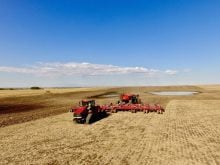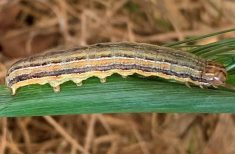Glacier FarmMedia — Satellite-based insurance technology could be a way to protect beef producers during times of drought.
There’s more interest in forage insurance during recent droughty times on the Prairies, but evaluating local forage risk is challenging.
“Weather events are becoming more acute in severity and frequency, you know the drought of 2023, 2021,” Damon Johnson, director of strategic projects for Global Ag Risk Solutions, said while presenting at the recent Saskatchewan Beef Industry Conference.
“But also, these climate events are becoming more chronic in their duration… we’ve had five of six dry years in a lot of places in Saskatchewan so that chronic nature for those adds risk to operations. So from a grassland production standpoint, feed availability is an issue on top of everybody’s mind.”
Read Also

Claas brings 1000 Series SP forage harvesters to Canada
In mid-August, Claas unveiled its new line of Jaguar forage harvesters at an event in Visalia, California, deep in the heart of that state’s dairy region.
Global Ag Risk Solutions has been selling insurance to producers since 2009, when it started by selling margin-based insurance to grain producers. The satellite-based insurance follows federal funding from the AgriRisk Initiative. The second phase is funded by Saskatchewan Crop Insurance (SCIC), Agriculture Financial Services Corp. in Alberta and Manitoba Agricultural Services Corp. The next phase is the development of the online sales platform. It’s using technology from Airbus, a European company that manufactures aircraft and satellites.
Unlike other types of insurance — such as forage rainfall insurance from SCIC, in which rainfall is measured based on weather stations at most 30 or 35 km away from the producer’s land — this type of satellite insurance wouldn’t measure rainfall. Instead, it would look at the vegetative index.
At the Saskatchewan conference, Johnson said Airbus’s Grasslands Production Index is being used in France to make an estimation of grass growth for cattle producers. According to Airbus’s website, the index is compared against historical averages and compensation is provided when the index falls below a preidentified threshold.
Johnson says the company hopes to do something similar in Canada.
“Every 10 days we’re getting a new update from the data in terms of (the satellite’s) suggestion of healthy forage crops,” he explains.
“We’re doing that over a really long history for insurance or financial mechanisms. Twenty years is the default… we’re looking to identify those shortfalls.”
Because of the satellite technology, this type of insurance would be able to provide local details using a mesh grid structure, in which it can go from a 100,000-foot view of Western Canada to zoom into different townships — or even closer.
“Going from township to even a smaller level and then doing so can be accurate and reliable,” Johnson says.
Johnson says the objectives of the project are to see if they can create an improved proxy for assessing grassland vegetation and feed availability shortfalls, as well as reduce the basis risk, which is a big motivator in creating insurance like this.
“Every type of insurance has basis risk built into it in varying degrees, and for us it was to explore: can we reduce that basis risk? Obviously, an example is the distance from a weather station, but that is a big one,” Johnson says.
Other objectives are to create scalability and ease of access for producers.
With technology from Airbus, Johnson says the company will be able to distinguish between soil types. He says it will also be able to create a target analysis of wet and dry years.
Johnson says the goal is to have the project extend across the Prairies. They are also engaging directly with livestock producers and working to get focus group feedback, he adds.
“There’s a lot of people, a lot of hands and a lot of ideas, but it’s really unified in terms of ‘Does a solution exist, and if it does, then how do we get into the market and what is the potential from a producer standpoint?’”
Johnson says future plans for the insurance include ongoing testing, as well as creating a web app in collaboration with the Canadian Cattle Association, which they hope to start soon.
While this type of insurance isn’t currently available, Johnson says a pilot project will likely be launched in 2024 with the insurance possibly becoming available in 2025.
















